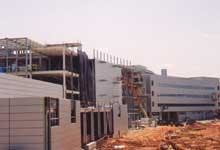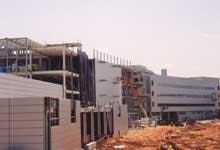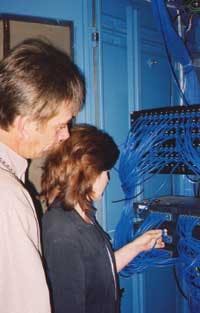The Spallation Neutron Source (SNS) being built at the Oak Ridge National Laboratory in Oak Ridge, TN is the largest United States government scientific project under construction. When completed in 2006, it will be the world's most powerful pulsed neutron source, letting scientists study and engineer materials at the atomic level.
Russ Henderson, staff communications engineer, is responsible for designing and building the voice and data communications network-with 6 million linear feet of fiber and 1,250 drops-that integrates the 38-acre facility into a seamless scientific community. "We probably have one of the largest fiber-backbone systems in the state of Tennessee, if not the eastern half of the United States," says Henderson. His team is part of the Commission Facility Group charged with providing SNS with utilities and services. The network will support the facility's personal-protection systems, machine-protection systems, as well as fire-alarm and standard voice and data systems.
Neutron beams are important tools for scientists who are studying and engineering the atomic structure of materials. The SNS neutron beam is created by firing an ion beam into a target of pure liquid mercury, which dislodges a large number of the mercury's neutrons. The freed neutrons are then formed into another beam of pure neutrons. When a material under study is bombarded with the neutron beam, some of the neutrons pass through while others ricochet or scatter when they come in contact with the test material's atomic nuclei. By studying the patterns of the scattered neutrons, scientists can learn how the material's atoms are structured.
Neutron scattering has resulted in the creation of many new materials that are applied in a wide range of products, including aircraft, computers, credit cards, and shatter-proof automobile windshields. The United States pioneered neutron-scattering technology, but 20 years ago, facilities built in Europe and Japan leapfrogged the U.S. technology. SNS is aimed at restoring American dominance in the field.
Six Department of Energy national laboratories are partnering to build and operate SNS. Each has assumed the responsibility for one of the facility's major systems that must work in concert to operate successfully. Integration can only be achieved through reliable voice and data communications, which have made reliability the driving force behind the network's design, construction, and maintenance.
SNS is similar to most construction sites where installed components must survive the hazards of the jobsite to perform as the network is activated. Henderson has been pleased with the performance of his connectivity components. "To me, one of the ultimate things that a company can say about its products is that they can survive the dirt, dust, and harsh conditions of the construction environment. We've been installing HellermannTyton products in a typical construction environment for over three years now and in that time, we've not had one single jack failure," says Henderson. "We've had plenty of failures of other network components due to dirt and other things, but we have yet to have one of our jacks fail."
Focus on component reliability
Stokes Electric Company (Knoxville, TN) is the distributor supplying SNS with its electrical, voice, and data communication systems. Vince Hayes, Stokes' data-communications sales manager, served on the front line of the SNS project and recognized that equipment would be subjected to environmental hazards that could affect performance and service life in ways that could not be accurately modeled. After surviving the everyday challenge of jobsite dirt and dust over the six-year building cycle, many of the 5,000 jacks and patch panels would need to perform to specification while being exposed to the potentially hazardous radiation and electrical noise generated by the powerful neutron beam.
Because of the unique application, all of the products had to go through rigorous testing before they were accepted for SNS. "There are similar products on the market, but everything is performance-based and the more performance you build into it, the better it's going to perform when it's installed," says Hayes. "Some other name brands that had been installed in like applications at the site failed when exposed to the radiation."
As a result, product reliability and customer service became important criteria in evaluating suppliers. Stokes had a long history of working with HellermannTyton, and Hayes believed the manufacturer's network connectivity components would meet the project's special requirements. The network was designed to Category 5e standards, but Henderson says the components have consistently tested to higher standards during routine installation testing.
The network is the communications backbone that provides real-time control of the neutron beam. The powerful beam shoots down a 500-foot tunnel in near proximity to the network cable and connections. Henderson believes everything has been done to minimize the effects that the powerful neutron beam might have on the network.
During the construction phase, all of the jacks have been tested with a test beam operating at lower power. But when the operating beam is brought online, it will generate up to 2 million megawatts, which is enough energy to power 30,000 homes. Operating a network within range of the electrical noise and radiation generated by the beam will be uncharted waters. "There is no test-case scenario for what we're doing here, but so far, it's worked," says Henderson. "We've been running at low power and we haven't had a single issue. The network is running within specification."
Warranty minimizes risk
SNS is a one-of-a-kind scientific research facility that requires a reliable voice and data communications network for its successful operation. Although the cost of downtime has been estimated at $38,000 per hour, the cost of losing valuable research time would drive the actual costs of lost, unrecoverable time much higher. In his planning and selection of suppliers, Henderson emphasized reducing the risks of everything that could lead to catastrophic failure, sublevel performance, or unacceptably high maintenance costs required to keep the network up and running.
Henderson's challenge was balancing current costs with future risks. It didn't take much imagination to visualize the consequences that an unplanned network shutdown would have on the facility's operation. Henderson also envisioned how future operating budgets could be devastated by the unplanned costs of outsourced resources scrambling to get the network back up and running. But practically anything that could be done during procurement and installation to reduce these future risks resulted in driving up current construction costs.
Henderson said he needed to consider how his current decisions would affect future budgets, but he also needed to work within the short-term budget. To reach decisions, Henderson looked beyond the initial purchase price and considered total life-cycle costs, including the acquisition, installation, maintenance, and potential replacement costs of network components.
Since quality components perform to specification only if they are properly installed and maintained, HellermannTyton's comprehensive warranty program was a key reason Henderson selected the manufacturer to supply network jacks and patch panels. All of the manufacturer's connectivity products are backed by a lifetime product-replacement warranty. But when a certified installer installs them, the company also covers the labor costs if they need to be replaced. Henderson estimated that it would cost between $500 and $550 to replace a faulty jack, and because of the large number of jacks deployed-some of which would be exposed to radiation-covering labor costs was important to him. HellermannTyton requires all installers to undergo a thorough training course to earn certification, and Henderson insisted that all installers working on the network earn the certification.
Tight construction deadlines were also a factor in the project, and it was critical to avoid lost time caused by potential shipping delays. Henderson credits the close working relationship between Stokes Electrical Company and HellermannTyton for having the product on-site when it was needed. "I don't know of one glitch that we had receiving product," Henderson says. "As far as I know, we never had to wait for anything. It's always been here when we needed it. And whenever we needed anything, our suppliers stepped up. For example, when a contractor's installers needed to be quickly trained to become certified, it was expedited so that installation could proceed on schedule."
With the beam scheduled to be fired up in a little more than a year, the network is near completion. Henderson, who has been working as an electrical engineer for nearly 30 years, says the groundbreaking work at SNS has been the highlight of his career: "I started out when I was 11 years old tearing apart radios, and then I moved on up to electronics and the whole nine yards. But I never imagined I would be working on something like this."
Henderson continues, "SNS will continue to evolve and grow. Right now, we have other scientists looking at adding another target building and additional laboratories on the campus. So, I think this could become one of the greatest research capitals of the world. We already have the latest and greatest technology here, but it's a 24-hour job to keep ahead of the curve so we can make sure that this network can do everything the scientists demand from it."
Author's note: The University of Tennessee-Battelle, SNS Project, and the companies affiliated with the SNS Project or Oak Ridge National Laboratories in no way recommend or endorse any persons or organizations mentioned in this story.
TERRY TUTTLE is director of marketing with HellermannTyton(www.hellermann.tyton.com).


